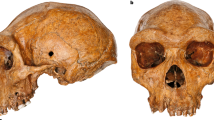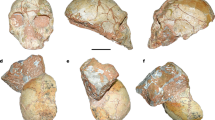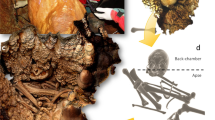Abstract
A key event in human evolution is the expansion of modern humans of African origin across Eurasia between 60 and 40 thousand years (kyr) before present (bp), replacing all other forms of hominins1. Owing to the scarcity of human fossils from this period, these ancestors of all present-day non-African modern populations remain largely enigmatic. Here we describe a partial calvaria, recently discovered at Manot Cave (Western Galilee, Israel) and dated to 54.7 ± 5.5 kyr bp (arithmetic mean ± 2 standard deviations) by uranium–thorium dating, that sheds light on this crucial event. The overall shape and discrete morphological features of the Manot 1 calvaria demonstrate that this partial skull is unequivocally modern. It is similar in shape to recent African skulls as well as to European skulls from the Upper Palaeolithic period, but different from most other early anatomically modern humans in the Levant. This suggests that the Manot people could be closely related to the first modern humans who later successfully colonized Europe. Thus, the anatomical features used to support the ‘assimilation model’ in Europe might not have been inherited from European Neanderthals, but rather from earlier Levantine populations. Moreover, at present, Manot 1 is the only modern human specimen to provide evidence that during the Middle to Upper Palaeolithic interface, both modern humans and Neanderthals contemporaneously inhabited the southern Levant, close in time to the likely interbreeding event with Neanderthals2,3.
This is a preview of subscription content, access via your institution
Access options
Subscribe to this journal
Receive 51 print issues and online access
$199.00 per year
only $3.90 per issue
Buy this article
- Purchase on Springer Link
- Instant access to full article PDF
Prices may be subject to local taxes which are calculated during checkout



Similar content being viewed by others
References
Hublin, J. J. The earliest modern human colonization of Europe. Proc. Natl Acad. Sci. USA 109, 13471–13472 (2012)
Sankararaman, S., Patterson, N., Li, H., Pääbo, S. & Reich, D. The date of interbreeding between Neandertals and modern humans. PLoS Genet. 8, e1002947 (2012)
Green, R. E. et al. A draft sequence of the Neandertal genome. Science 328, 710–722 (2010)
Marder, O. et al. The Upper Palaeolithic of Manot Cave, Western Galilee, Israel: the 2011–12 excavations. Antiquity 87, http://antiquity.ac.uk/projgall/marder337 (2013)
Mercier, N. et al. Thermoluminescence date for the Mousterian burial site of Es-Skhul, Mt. Carmel. J. Archaeol. Sci. 20, 169–174 (1993)
Valladas, H. et al. Thermoluminescence dates for the Neanderthal burial site at Kebara in Israel. Nature 330, 159–160 (1987)
Haile-Selassie, Y., Asfaw, B. & White, T. D. Hominid cranial remains from Upper Pleistocene deposits at Aduma, Middle Awash, Ethiopia. Am. J. Phys. Anthropol. 123, 1–10 (2004)
Smith, F. H., Janković, I. & Karavanić, I. The assimilation model, modern human origins in Europe, and the extinction of Neandertals. Quat. Int. 137, 7–19 (2005)
Balzeau, A. & Rougier, H. Is the suprainiac fossa a Neandertal autapomorphy? A complementary external and internal investigation. J. Hum. Evol. 58, 1–22 (2010)
Hublin, J. J. in L’Homme de Néandertal 3: l’Anatomie 67–73 (ed. Trinkaus, E. ) (E.R.A.U.L., 1988)
Dean, D., Hublin, J. J., Holloway, R. & Ziegler, R. On the phylogenetic position of the pre-Neandertal specimen from Reilingen, Germany. J. Hum. Evol. 34, 485–508 (1998)
Harvati, K., Gunz, P. & Grigorescu, D. Cioclovina (Romania): affinities of an early modern European. J. Hum. Evol. 53, 732–746 (2007)
Hublin, J. J. A propos de restes inédits du gisement de La Quina (Charente): un trait méconnu des néandertaliens et des prénéandertaliens. Anthropologie 84, 81–88 (1980)
Crevecoeur, I., Rougier, H., Grine, F. & Froment, A. Modern human cranial diversity in the Late Pleistocene of Africa and Eurasia: evidence from Nazlet Khater, Peştera cu Oase, and Hofmeyr. Am. J. Phys. Anthropol. 140, 347–358 (2009)
Harvati, K. et al. The Later Stone Age calvaria from Iwo Eleru, Nigeria: morphology and chronology. PLoS ONE 6, e24024 (2011)
Weber, G. W. & Bookstein, F. L. Virtual Anthropology: A Guide to a New Interdisciplinary Field (Springer, 2011)
Gunz, P. et al. Early modern human diversity suggests subdivided population structure and a complex out-of-Africa scenario. Proc. Natl Acad. Sci. USA 106, 6094–6098 (2009)
Schwartz, J. H. & Tattersall, I. Fossil evidence for the origin of Homo sapiens. Am. J. Phys. Anthropol. 143, 94–121 (2010)
Soares, P. et al. The expansion of mtDNA haplogroup L3 within and out of Africa. Mol. Biol. Evol. 29, 915–927 (2012)
Ingman, M., Kaessmann, H., Pääbo, S. & Gyllensten, U. Mitochondrial genome variation and the origin of modern humans. Nature 408, 708–713 (2000)
Mellars, P., Gori, K. C., Carr, M., Soares, P. A. & Richards, M. B. Genetic and archaeological perspectives on the initial modern human colonization of southern Asia. Proc. Natl Acad. Sci. USA 110, 10699–10704 (2013)
Reyes-Centeno, H. et al. Genomic and cranial phenotype data support multiple modern human dispersals from Africa and a southern route into Asia. Proc. Natl Acad. Sci. USA 111, 7248–7253 (2014)
Wolpoff, M. H., Hawks, J., Frayer, D. W. & Hunley, K. Modern human ancestry at the peripheries: a test of the replacement theory. Science 291, 293–297 (2001)
Duarte, C. et al. The early Upper Paleolithic human skeleton from the Abrigo do Lagar Velho (Portugal) and modern human emergence in Iberia. Proc. Natl Acad. Sci. USA 96, 7604–7609 (1999)
Reich, D. et al. Genetic history of an archaic hominin group from Denisova Cave in Siberia. Nature 468, 1053–1060 (2010)
Fu, Q. et al. Genome sequence of a 45,000-year-old modern human from western Siberia. Nature 514, 445–450 (2014)
Grün, R. et al. U-series and ESR analyses of bones and teeth relating to the human burials from Skhul. J. Hum. Evol. 49, 316–334 (2005)
Grün, R. & Stringer, C. Tabun revisited: revised ESR chronology and new ESR and U-series analyses of dental material from Tabun C1. J. Hum. Evol. 39, 601–612 (2000)
Bar-Matthews, M., Ayalon, A., Gilmour, M., Matthews, A. & Hawkesworth, C. J. Sea-land oxygen isotopic relationships from planktonic foraminifera and speleothems in the Eastern Mediterranean region and their implication for paleorainfall during interglacial intervals. Geochim. Cosmochim. Acta 67, 3181–3199 (2003)
Higham, T. et al. The timing and spatiotemporal patterning of Neanderthal disappearance. Nature 512, 306–309 (2014)
Balzeau, A., Grimaud-Hervé, D. & Gilissen, E. Where are inion and endinion? Variations of the exo- and endocranial morphology of the occipital bone during hominin evolution. J. Hum. Evol. 61, 488–502 (2011)
Hershkovitz, I. et al. Ohalo II H2: A 19,000-year-old skeleton from a water-logged site at the Sea of Galilee, Israel. Am. J. Phys. Anthropol. 96, 215–234 (1995)
Arensburg, B. The People in the Land of Israel from the Epipaleolithic to the Present Times: A Study Based on their Skeleton Remains. PhD thesis, Tel Aviv Univ. (1973)
Takai, H. & Suzuki, F. The Amud Man and his Cave Site 123–206 (Univ. Tokyo, 1970)
Lieberman, D. E. How and why humans grow thin skulls: experimental evidence for systemic cortical robusticity. Am. J. Phys. Anthropol. 101, 217–236 (1996)
Acknowledgements
The excavation at Manot Cave was initiated and supported throughout the years by the late D. David, founder of the ‘Dan David Prize’, and his son A. David. The ongoing research is financially supported by the Dan David Foundation, the Israel Antiquities Authority, Case Western Reserve University, the Leakey Foundation, the Irene Levi Sala CARE Archaeological Foundation, the Keren Kayemet L’Israel and the Israel Science Foundation. Radiocarbon dating research has been supported by the National Science Foundation, the Exilarch’s Foundation and the Max Planck Society–Weizman Institute Joint Center for Integrative Archaeology and Anthropology. Geological research was supported by The Bertha and Louis Weinstein Research Fund. We thank other research members of the Manot team: J.-M. Tejero and S. Weiner. We thank A. Behar and L. Barda for their drawings, C. Amit for the photography of the skull, and V. Essman and Y. Shmidov for surveying and drafting the cave. We thank I. Mureinik for editorial assistance. Special thanks are due to the following students and scholars: L. Weissbrod, D. Stein, H. Cohen, B. Medlej, M. Feldman, O. Hay, T. Abulafia, L. Davis, N. Schneller-Pels, D. Yegorov, M. Ullman and G. Hertzelinger. Thanks are also due to the Maale Yossef Regional Council, the residents of modern Manot and N. Reuven. We are also grateful to the late S. Dorfman, U. Dahari, D. Barshad, E. Stern and J. Goldberg. We thank I. Gilead and O. Bar-Yosef for reading and commenting on a previous version of this paper. We are grateful to C. Stringer for comments and suggestions.
Author information
Authors and Affiliations
Contributions
I.H., O.B. and O.M. are directing the Manot cave research project. I.H., P.G., B.L., V.S., G.W.W., H.M., M.G.H. and R.L.H. performed the various aspects of the anthropological study of the Manot 1 calvaria. O.B., O.M., R.L. and M.G.G. conducted the archaeological studies at the cave. A.A., M.B.-M., G.Y. and A.M. conducted the U–Th dating of the calcitic crust on the Manot 1 calvaria and of speleothems in the cave. A.F. and F.B. conducted the geological study of the cave. E.B., V.C. and B.A. performed the radiocarbon dating and charcoal analysis. G.B.-O., R.Y. and D.B.-Y.M. conducted the study of the faunal remains.
Corresponding author
Ethics declarations
Competing interests
The authors declare no competing financial interests.
Extended data figures and tables
Extended Data Figure 1 Plan of Manot Cave.
The excavation areas are shown. The upper photograph shows the chamber in which Manot 1 was found (yellow circle) (looking east). The lower photograph shows the stratigraphic profile of Area C (looking west). Note the eight different sedimentological units.
Extended Data Figure 2 Diagnostic flint and bone artefacts from Area C.
Upper Palaeolithic, a–k; Initial Upper Palaeolithic, l–n; Middle Palaeolithic, o. a, Aurignacian endscrapers. b, Carinated endscrapers. c, Nosed endscrapers. d, Curved–twisted bladelet. e, Antler spear points. f, Ahmarian blades. g, Ahmarian blade cores. h, Retouched blade. i, Endscraper on a blade. j, Burin on truncation on a blade. k, El-Wad points. l, Wide blade cores. m, Blades with faceted butts. n, Endscraper. o, Levallois points and flakes.
Extended Data Figure 3 Crust sampling for dating.
The outer (a) and inner (b) parts of the skull showing the locations of sampling for U–Th dating and the dating results. Ages are in thousands of years, errors are at 2σ.
Extended Data Figure 4 Dating results for Area C.
a, U–Th dates (white boxes) are of flowstone layers and the crust covering an archaeological artefact (sample 1029). Radiocarbon dates (yellow box) are of the archaeological accumulation between the flowstone layers of square M65. b, Dates of radiocarbon samples from Squares M65 and J65. Radiocarbon sample number, material type, 14C age ± 1σ, calibrated range for 68.2% and 95.4% confidence intervals, sample identity, percentage of carbon after pre-treatment and stable carbon isotopes ratio are given. Samples from square M65 are ordered according to absolute height above sea level.
Extended Data Figure 5 U–Th ages of stalagmites 1020, 1044, 1045 and 1048.
a-d, Photographs of the stalagmites, showing the position of the dated laminae. Ages are in thousands of years, errors are at 2σ. e, U–Th ages of the four stalagmites, plotted in stratigraphic sequence (open symbols, uncorrected ages; solid symbols, corrected ages). Grey and black bars indicate errors on uncorrected and corrected ages, respectively. f, 230Th/234U versus 232Th/234U isochron plots from eight different laminae, sampled from the four speleothems.
Supplementary information
Supplementary Information
This file contains Supplementary Text and Supplementary References – see Contents for details. (PDF 1535 kb)
Supplementary Table 1
This file contains detailed age determination results of flowstones, stalagmites and calcitic crusts. (XLSX 21 kb)
Rights and permissions
About this article
Cite this article
Hershkovitz, I., Marder, O., Ayalon, A. et al. Levantine cranium from Manot Cave (Israel) foreshadows the first European modern humans. Nature 520, 216–219 (2015). https://doi.org/10.1038/nature14134
Received:
Accepted:
Published:
Issue Date:
DOI: https://doi.org/10.1038/nature14134
This article is cited by
-
Evidence of diverse animal exploitation during the Middle Paleolithic at Ghar-e Boof (southern Zagros)
Scientific Reports (2023)
-
Intra-Site Structure of the Early Ahmarian Site of Al-Ansab 1, AH 1 (Jordan)
Journal of Paleolithic Archaeology (2022)
-
Nubian Levallois technology associated with southernmost Neanderthals
Scientific Reports (2021)
Comments
By submitting a comment you agree to abide by our Terms and Community Guidelines. If you find something abusive or that does not comply with our terms or guidelines please flag it as inappropriate.



